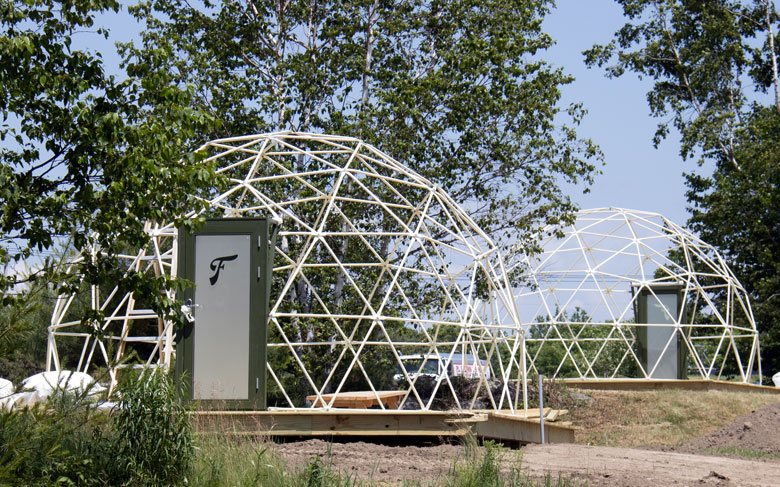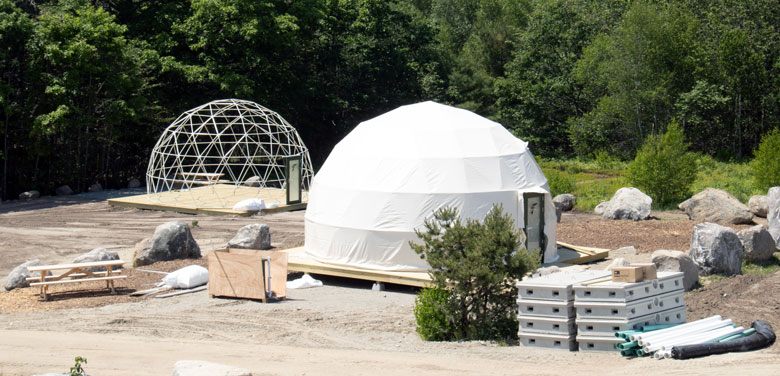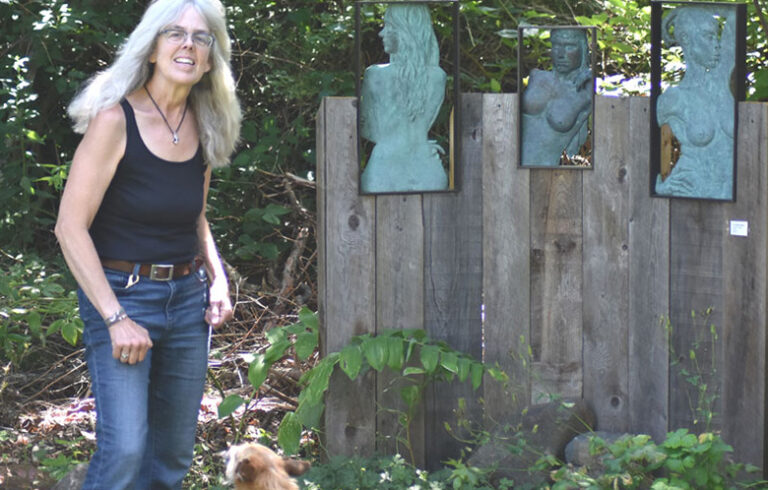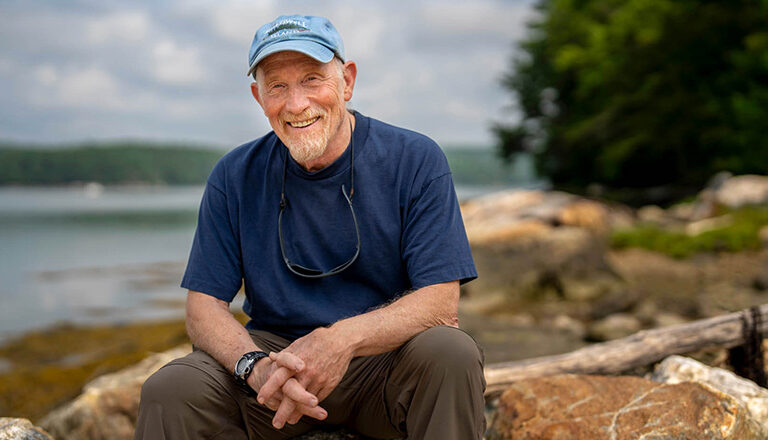Ferncrest Acadia is one of the newest glamorous camping or “glamping” businesses to come to the coast of Maine. Its futuristic geodesic domes sprang up on a former blueberry barren that once housed a local take-out shack and mini golf course in Sedgwick, a small town on the Blue Hill Peninsula.
Ferncrest Acadia’s owner, Caleb Scott, also operates a small traditional campground in nearby Deer Isle. After a few years of operation, Scott’s 4-acre camp reached maximum capacity. He decided to expand into Maine’s rapidly growing glamping industry.
“Glamping is still new, but in the years to come, I see it as essentially a blue ocean. [The market] is wide open,” he said.
Ferncrest Acadia is expected to open in early August. Like a lot of glampgrounds in the region, Scott’s new venture was set against a vocal group of neighbors and residents who had a host of objections to the project.
As its name suggests, glamping is a marriage between the natural setting of a campground and the glamorous amenities of a luxury hotel.
“Glamping is a hybrid. It allows people to have the comforts of home. They have beds, they have premium amenities but they have the ability to disconnect in the woods.”
Some of glamping’s allure comes from its unusual dwellings. Scott’s glampground features 400-square-foot plastic-covered domes with windows, offering panoramic views of the landscape.
Other glampgrounds have large “safari style” canvas tents, yurts, cabins, and even tree houses. Most glamping accommodations come complete with king beds, private bathrooms, and electricity. The properties themselves usually feature restaurants, stores, wellness centers, and common spaces for guests.
“Glamping is a hybrid,” Scott said. “It allows people to have the comforts of home. They have beds, they have premium amenities but they have the ability to disconnect in the woods.”
The glamping industry has generally seen tremendous growth in the past decade. A 2022 report from Kampgrounds of America (KOA) found that the number of U.S. glamping brands grew from 59 in 2012 to 230 in 2022. The report estimates that over 17 million households went on at least one glamping trip in 2021.
A 2025 KOA report shows the number of new glamping guests dropped significantly after peaking in 2021 but has been steadily increasing each year since. It estimates that glampers made up a third of all camping guests in 2024. KOA’s report also found that over 60 percent of glamping guests have children, and almost half are millennials.
In Maine, the area around Acadia National Park, which attracts four million visitors annually, has seen several glampgrounds emerge in recent years.
In 2020, KOA—one of the largest camping corporations in the country—converted its traditional Bar Harbor campground into Terramor, a luxury glamping resort. The Montana-based glamping company Under Canvas opened Under Canvas Acadia in Surry in 2021. In 2022, the glamping site Acadia Wilderness Lodge opened in Tremont, just a few minutes away from Acadia National Park.
“People want to be able to be close enough to attractions that bring them to Maine, but—in our case—they want to have a nice, quiet, relaxing place to come to at the end of the day,” said Dan Cashman, spokesperson for Acadia Wilderness Lodge.
GROWTH SPURS RESISTANCE
As business continues to grow, glampground development in Maine has run into resistance from towns, neighboring landowners, and groups of residents.
Because the industry is relatively new, glamping developments often aren’t written into local land use laws, unlike motels, hotels, and traditional campgrounds.
In Tremont, the permitting process for Acadia Wilderness Lodge took more than a year while the town grappled with changing definitions in its zoning. The project also faced resistance from a group called Concerned Tremont Residents. The glampground was eventually approved but, in 2023, Lamoine voters passed an addition to its land use ordinance that limited the size and density of all “recreational lodging facilities.”

“A lot of ordinances, especially in small towns, aren’t written to recognize these types of structures,” said Tremont’s code enforcement officer, Angela Chamberlain.
That same year, the Arizona-based company Clear Sky Resorts proposed 90 geodesic domes on a property in Lamoine. The project was halted and ultimately abandoned after residents passed a 180-day moratorium on campground development. Lamoine later added glamping to the list of definitions in its building and land use ordinance.
In 2024, a two-year-long permitting process for a proposed glampground in Deer Isle ended in a lawsuit between the out-of-state developer, the town, and a small group of citizens. The lawsuit was dropped after the developer walked away from the project, eventually selling the 40-acre property to a local nonprofit land trust. Along the way, Deer Isle voters approved a wholly new commercial building ordinance that, among other things, limited the size of campgrounds and glampgrounds.
Scott submitted his permit application for Ferncrest Acadia in May of this year. Within days, a Facebook group opposing the project amassed several hundred members under the banner “Grow the Peninsula Responsibly.”
The group raised concerns about water usage, stormwater management, traffic, and increased use of boat landings and swimming spots. They attempted to block the development with a 180-day moratorium but were unable to complete the process before Sedgwick’s planning board approved Scott’s permit, allowing him to move forward.
The business models of Maine’s glampgrounds are almost as diverse as their lodging options. Some, like Under Canvas in Surry and KOA’s Terramor resort in Bar Harbor, are owned by large companies that operate nationwide. Some small local campgrounds have added a few glamping tents to their existing sites. Others, like Acadia Wilderness Lodge, are owner operated.
Scott lives year-round near his new glampground. He and his family manage the business, but it is a franchise of Ferncrest, a glamping company based in Pennsylvania. Ferncrest supplies the dome tents, the blueprints for buildings, handles booking, and uses its large social media following to drive marketing. Scott pays an initial franchise fee and a percentage of his annual revenue to Ferncrest.
“[Ferncrest] provides a lot of assistance and support to their franchisees to handle a lot of the back-end stuff,” Scott said. “A lot of the things that, when you start your own business, are a little overwhelming.”
Scott’s 30-acre property is the third glampground in the Ferncrest franchise, with the other two locations in Pennsylvania and Oklahoma. As the glamping industry continues to grow nationally, Scott said the company is looking to expand around the country, with the goal of roughly a dozen new glamping franchisees within a year.
Existing glampgrounds in Maine have also announced upcoming expansions. Under Canvas and Acadia Wilderness lodge both intend to add more lodging capacity over the next several years.
Cashman, speaking for Acadia Wilderness Lodge, said the glamping resort sees about 1,500 guests per season with its eight yurts. The company hopes to add more yurts and glamping tents to meet a growing demand.
“We know that we are not alone in this business, so it is gaining traction through our efforts as well as other operators who are acting in good faith,” Cashman said.





